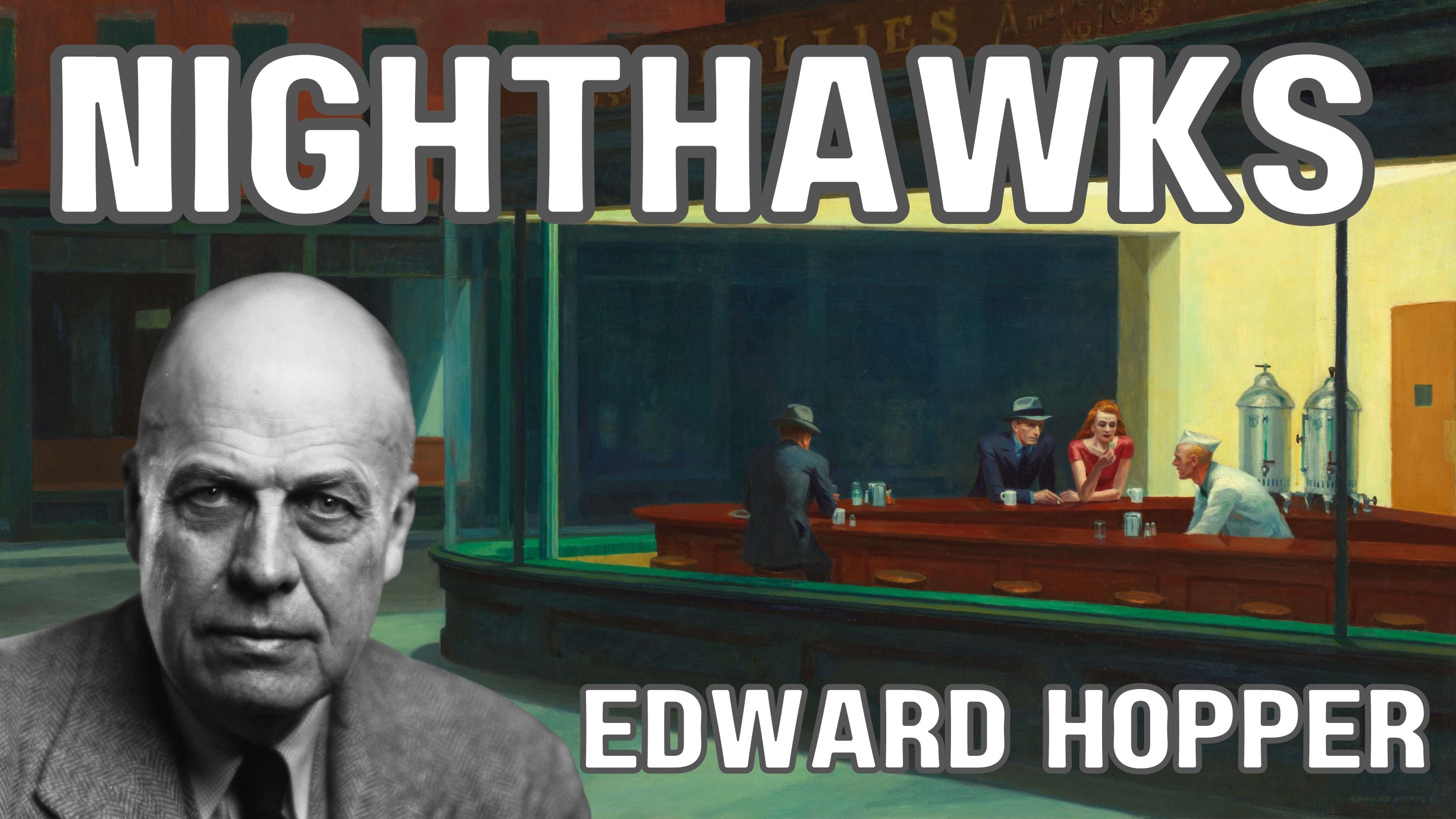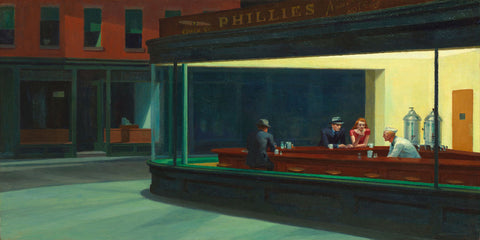Table of Contents:[hide]
Edward Hopper's 1942 masterpiece, Nighthawks, has transcended the realm of mere painting to become an iconic symbol of urban solitude and introspection. Bathed in the stark glow of a diner's neon sign, the scene depicts a late-night tableau of isolation amidst the city's restless hum. Every brushstroke, every deliberate detail, speaks volumes about the human condition, inviting viewers into a world of unspoken narratives and quiet contemplation.
Deconstructing the Composition - A Masterclass in Minimalism
Hopper's genius lies in his ability to weave magic with stark simplicity. The diner occupies the majority of the canvas, its elongated form stretching across the foreground like a lonely island in a sea of darkness. The large windows act as a stage, revealing the drama unfolding within. Three lone figures – a couple in a booth and a lone counterman – occupy the space, their silhouettes stark against the diner's warm glow.
The Languid Dance of Light and Shadow:
Hopper's masterful use of light and shadow is central to the painting's evocative power. The diner's neon sign casts a harsh, artificial light, illuminating the interior but leaving the street outside shrouded in darkness. This stark contrast heightens the sense of isolation, emphasizing the diner's detachment from the city's nocturnal pulse.
A Symphony of Stillness:
The painting is remarkably devoid of movement. The figures are frozen in time, their postures conveying a sense of ennui and detachment. The counterman leans against the counter, his back turned to the couple, while the couple themselves seem lost in their own thoughts, barely acknowledging each other's presence. This stillness amplifies the painting's melancholic air, inviting viewers to ponder the characters' unspoken stories and the weight of their solitude.
Delving into the Depths - Hopper's Muse: The American Psyche
Nighthawks is not merely a snapshot of a late-night diner; it is a profound meditation on the human condition in the modern world. Hopper's characters embody a sense of alienation and anonymity that resonated deeply with the American experience of the mid-20th century. The diner, a quintessential symbol of American roadside culture, becomes a metaphor for the loneliness and disconnectedness that pervaded a society grappling with rapid urbanization and the erosion of traditional values.
Echoes of Hemingway:
The painting's starkness and emotional ambiguity evoke the minimalist prose of Ernest Hemingway, another chronicler of American disillusionment. Just like Hemingway's characters, Hopper's figures are adrift in a sea of existential angst, their silhouetted forms conveying a sense of unspoken longing and lost connection.
A Timeless Canvas:
While Nighthawks is rooted in a specific historical context, its themes of loneliness, isolation, and the search for meaning remain universally relevant. The painting continues to resonate with viewers across generations and cultures, prompting introspection and inviting contemplation about our own place in the urban landscape.
Beyond the Diner Walls - Nighthawks' Enduring Legacy
Nighthawks' influence extends far beyond the art world. The painting has been referenced in countless films, songs, and literary works, serving as a visual shorthand for urban solitude and existential angst. Its iconic status is a testament to Hopper's ability to capture a universal human experience with such raw honesty and emotional depth.
A Canvas for Interpretation:
The beauty of Nighthawks lies in its ambiguity. Hopper provides no clues about the characters' inner lives or their relationships. This deliberate open-endedness allows viewers to project their own interpretations onto the canvas, making the painting a springboard for personal reflection and storytelling.
An Enduring Source of Inspiration:
Nighthawks continues to inspire artists and creatives of all disciplines. Its minimalist composition, evocative use of light and shadow, and timeless themes provide endless possibilities for interpretation and reimagining. From contemporary art installations to graphic novels, Nighthawks' influence can be seen in diverse artistic expressions, solidifying its place as a cultural touchstone.
Conclusion - A Window into the Soul of a City
Nighthawks is more than just a painting; it is a portal into the soul of a city and the hearts of its inhabitants. Through its masterful composition, evocative use of light and shadow, and exploration of universal themes, Nighthawks invites us to confront the beauty and the pain of human existence in the modern world. It is a timeless masterpiece that continues to captivate and inspire, reminding us that even in the midst of urban anonymity, there is a flicker of humanity, a silent yearning for connection, waiting to be discovered in the dimly lit corners of our lives.
Nighthawks' enduring legacy lies in its ability to transcend the canvas and spark dialogue – about art, about society, about ourselves. It encourages us to look beyond the surface, to delve into the unspoken stories of the individuals we encounter, and to appreciate the subtle beauty that can be found even in the midst of loneliness.
Ultimately, Nighthawks is a reminder that we are not alone. Though the characters within the diner may appear isolated, their shared experience of human existence binds them to us, the viewers, across time and space. We see ourselves reflected in their vacant eyes, our own quiet moments of contemplation mirrored in the stillness of the scene.
Thus, Nighthawks is not just a painting; it is a conversation starter, a catalyst for empathy, and a testament to the enduring power of art to connect us to ourselves and to each other.
Nighthawks: Frequently Asked Questions
1. What is the meaning of Nighthawks?
Hopper famously stated that he wasn't aiming for a specific meaning, believing that "a painting is more a mood than a story." However, the painting's starkness, isolation, and use of contrasting light and shadow invite viewers to project their own interpretations. Common themes explored include:
- Urban loneliness: The characters appear disconnected, lost in their own thoughts in the midst of a bustling city.
- Existentialism: The lack of detail about the figures' lives leaves viewers wondering about their purpose and place in the world.
- The American Dream: The diner, a symbol of American roadside culture, may be seen as a hollow promise of satisfaction and connection.
- Modern alienation: The painting reflects the anxieties and loneliness that people felt in the mid-20th century, especially in increasingly urbanized societies.
Ultimately, the meaning of Nighthawks is open to interpretation, making it a powerful and enduring work of art.
2. Who are the people in Nighthawks?
We don't know the identities or relationships of the three figures in the diner. Hopper deliberately left them anonymous, adding to the sense of mystery and isolation. The couple in the booth sit stiffly, barely acknowledging each other, while the lone counterman gazes into the distance, seemingly lost in thought. Their lack of interaction and expression allows viewers to imagine their own stories and motivations.
3. Where is the diner in Nighthawks?
The diner itself is fictional, though Hopper drew inspiration from real-life establishments he saw in New York City. He combined architectural elements from various diners and imagined the street scene. This further contributes to the painting's universality, as it doesn't depict a specific location but rather captures the essence of countless anonymous late-night eateries.
4. What is the significance of the light in Nighthawks?
Hopper's masterful use of light and shadow plays a crucial role in the painting's mood and symbolism. The harsh neon glow of the diner sign casts long shadows, creating a stark contrast between the interior's artificial warmth and the enveloping darkness of the street outside. This contrast highlights the isolation of the characters within the diner and emphasizes the feeling of being alone even in the midst of urban activity.
5. Why is Nighthawks so famous?
Nighthawks' popularity stems from several factors:
- Relatable themes: The painting's exploration of loneliness, isolation, and existentialism resonates with viewers across generations and cultures.
- Masterful composition: Hopper's minimalist style, use of light and shadow, and deliberate ambiguity create a visually striking and thought-provoking experience.
- Cultural significance: Nighthawks has become a cultural touchstone, referenced in countless films, songs, and literature, solidifying its place in the American artistic canon.
Nighthawks - Prints and Canvas Panels


